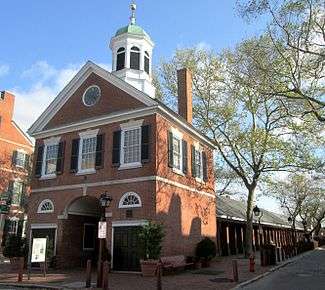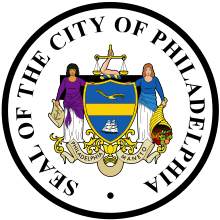New Market and Head House
|
New Market | |
 Head House (left) and market sheds (right) (2013) | |
   | |
| Location |
S. 2nd St., between Pine & Lombard Sts. Philadelphia, Pennsylvania |
|---|---|
| Coordinates | 39°56′35″N 75°8′43″W / 39.94306°N 75.14528°WCoordinates: 39°56′35″N 75°8′43″W / 39.94306°N 75.14528°W |
| Area | 2 acres (0.81 ha) |
| Built |
Market: 1745 Head House: 1804 |
| Architect | unknown |
| Architectural style | Georgian |
| Part of | Head House Square (#72001158) |
| NRHP reference # | 66000686[1] |
| Significant dates | |
| Added to NRHP | November 13, 1966 |
| Designated CP | June 19, 1972 |
New Market, as it was originally known, and later also known as Head House (or Headhouse) Market and Second Street Market, is a historic street market on South 2nd Street between Pine and Lombard Streets in the Society Hill neighborhood of Philadelphia, Pennsylvania. With a history dating to 1745, it is one of the oldest surviving market buildings of its type in the nation. This portion, which survives from a longer structure originally extending all the way to South Street, was designated a National Historic Landmark in 1966, and is the centerpiece of the Head House Square historic district.
History
Established on Lombard Street in 1745 by mayor Edward Shippen and Joseph Wharton, a wealthy merchant,[2] and named "New Market" to distinguish it from the established market on High (now Market) St., the market was used well into the 19th century. It originally consisted of 16 stalls[2] created by two rows of brick pillars supporting a gable roof and arched ceiling over an open market area, known as the Shambles. By 1797 it had extended to South Street, where it ended in a firehouse, which was later demolished, and eventually extended north to Pine Street as well.[2]
In 1804, Joseph Wetherill, a wealthy merchant and master builder, encouraged the City of Philadelphia to erect the Head House at the north end of New Market (Second Street), for which he loaned the city $1,000.[3] The Head House, a Georgian-style brick firehouse with Federal-style ornamentation, was built at the north end of the market; the building's cupola once housed a firebell.[2] The firehouse is the oldest extant in the United States, and is now used as a community center.
The market reached its greatest extent, all the way to South Street, by 1811. The market section between Pine and Lombard underwent a major restoration in 1923, which replaced the roof and a number of brick piers.[4] The Head House has also undergone restoration.
The area around the building, known as Head House Square, features cobblestone streets and a park, as well as one of the oldest continuously run farmer's markets in the nation. The farmer's market is open on Sundays from the first week in May through the week before Christmas, from 10 am to 2 pm, selling locally grown produce and other farm products.
The site was declared a National Historic Landmark on November 13, 1966.[5] It is a contributing property of the Head House Square National Historic District. It was restored in 1994 by the Head House Conservancy, a non-profit organization.
See also
References
- ↑ National Park Service (2007-01-23). "National Register Information System". National Register of Historic Places. National Park Service.
- 1 2 3 4 Gallery, John Andrew, ed. (2004), Philadelphia Architecture: A Guide to the City (2nd ed.), Philadelphia: Foundation for Architecture, ISBN 0962290815 , p. 25
- ↑ " Wetherill, Joseph (1740 - 1820): Master Builder; Lumber Merchant; Philadelphia Inspector of Lumber" Philadelphia Architects and Builders website
- ↑ "NHL nomination for New Market". National Park Service. Retrieved 2017-03-23.
- ↑ Listing at National Park Service
External links

- Listing and image at USHistory.org
- Hope Hose Company No. 6 & Fellowship Engine Company No. 29 at the Historic American Buildings Survey
- Listing and images of Headhouse and Market at Philadelphia Architects and Buildings
- Listing of Headhouse's South Fountain at Philadelphia Architects and Buildings
- The farmer's market


